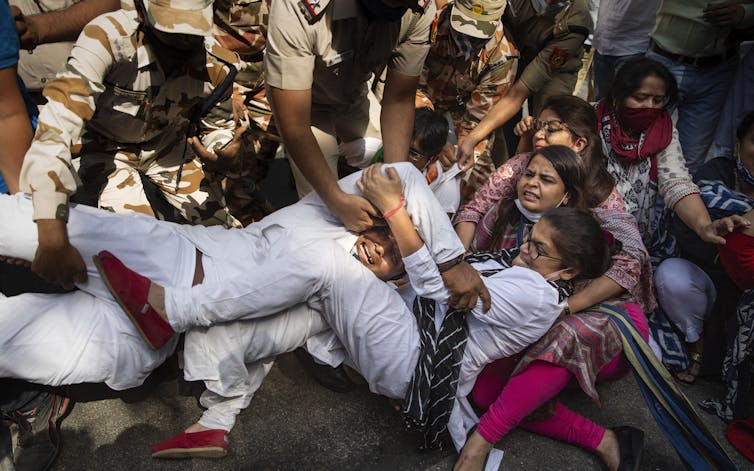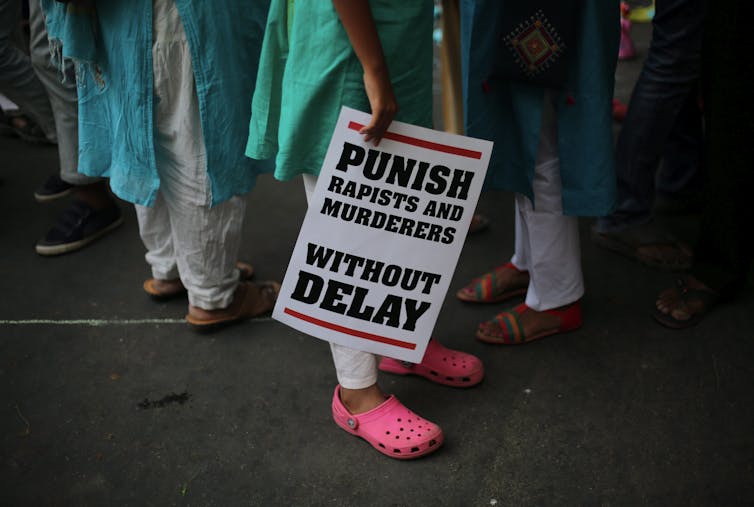
Deeplina Banerjee, Western University
After details of a violent gang rape in Hathras, Uttar Pradesh, were released to the public last year, protests broke out all over India. The story of four upper-caste men brutalizing a 19-year old Dalit woman, and her subsequent death from injuries sent shock waves throughout the country. It set off new conversations about violence against marginalized women in India, challenging both traditional spaces and the urban middle- to upper-class Me Too movement.
The Hathras case follows a 2012 Delhi gang rape that galvanized a national debate on the treatment of women. The Hathras story is a reminder of the ongoing violence Dalit women in India experience.
Although India’s caste system was officially outlawed in 1950, caste-based discrimination is still very much in practice. It positions Dalit women at the bottom of the social hierarchy and normalizes rape and sexual violence by upper-caste men. The Dalit community makes up about 25 per cent of India’s population. Indigenous communities (Advasis) have also been marginalized.

Despite the awareness, the levels of violence against marginalized women in India continue to rise. According to the National Crime Records Bureau 26 per cent of reported violent cases against women are instances of men raping Dalit women. The government data reveal that at least 10 Dalit women and girls are raped daily in India, although the figure is likely much higher as many do not report these incidents out of shame, stigma and fear of violence from the perpetrators.
Systemic caste violence
Even after police departments all over the country faced both international and local pressure to deal with the issue, problems with policing continue. Apart from the stigmatization and shame associated with rape, there is limited legal or social support available to women for redressing the violence.
In Hathras, police not only delayed registering the first information report, but also provided little support to the victim’s family. The failure and apathy to hold perpetrators accountable contributes to systemic impunity for upper-caste men who enable violence.
Explaining the caste system in India, social reformer B.R. Ambedkar noted that Brahmins, or the upper caste, maintained the hierarchy by systematically excluding lower-caste Dalits. The Dalits, once called “the untouchables,” help to preserve the notion of upper-caste “purity” and rank.
Ambedkar said the systematic internalization of the caste hierarchy prevents lower-caste people from challenging the system.
The patriarchal view of upper- and lower-caste women are vastly different. Upper-caste female bodies have historically been constructed as desirable, racially pure and protected, so as to maintain caste-purity. On the other hand, lower-caste and Dalit women’s bodies are constructed as readily available and without any subjectivity. Religious customs and social norms have allowed upper-caste men to have easy access to Dalit women’s bodies. Caste-supremacy is maintained through Dalit women’s bodies.
Seeking intersectional feminist solidarity
The Me Too movement has enabled many Indian women to forge bonds over shared experiences of sexual vulnerabilities allowing them to hold their abusers accountable. The movement has contributed towards a sense of public acknowledgement of the pervasiveness of sexual violence in India and an abuse of power in the workplace dominated by upper-caste men.

However, feminist solidarity in India will take a huge blow if women’s movements don’t acknowledge the role of caste in the perpetration of sexual violence against women. Many upper-caste women remain complicit in caste-hierarchy as it benefits them and affords them social mobility and access to economic benefit.
Feminist writer and researcher Sanjana Pegu argues that feminist activists need to move beyond the individualist narratives of sexual harassment in the workplace and at home to develop inclusive documentation of women’s experiences of sexual violence.
Marginalized “working class” women without access to social media have limited access to the Me Too movement, which is limited to urban women with a fair amount of social mobility.
Many upper-caste women have spoken about their personal experiences of violence without acknowledging how their lives have benefited from keeping Dalit women in the margins. Feminist movements in India need to collaborate on and advance the demands for justice over sexualized crimes. To do so, organizations need to develop an intersectional approach, allowing Dalit women to take the lead. Doing this work could help challenge caste bias in the legal and institutional systems.
Indians need to acknowledge the plight of Dalit women. The Indian government needs to start calling it what it is — caste-based gendercide — and take action now.![]()
Deeplina Banerjee, PhD Student, Gender, Sexuality and Women Studies, Western University
This article is republished from The Conversation under a Creative Commons license. Read the original article.

